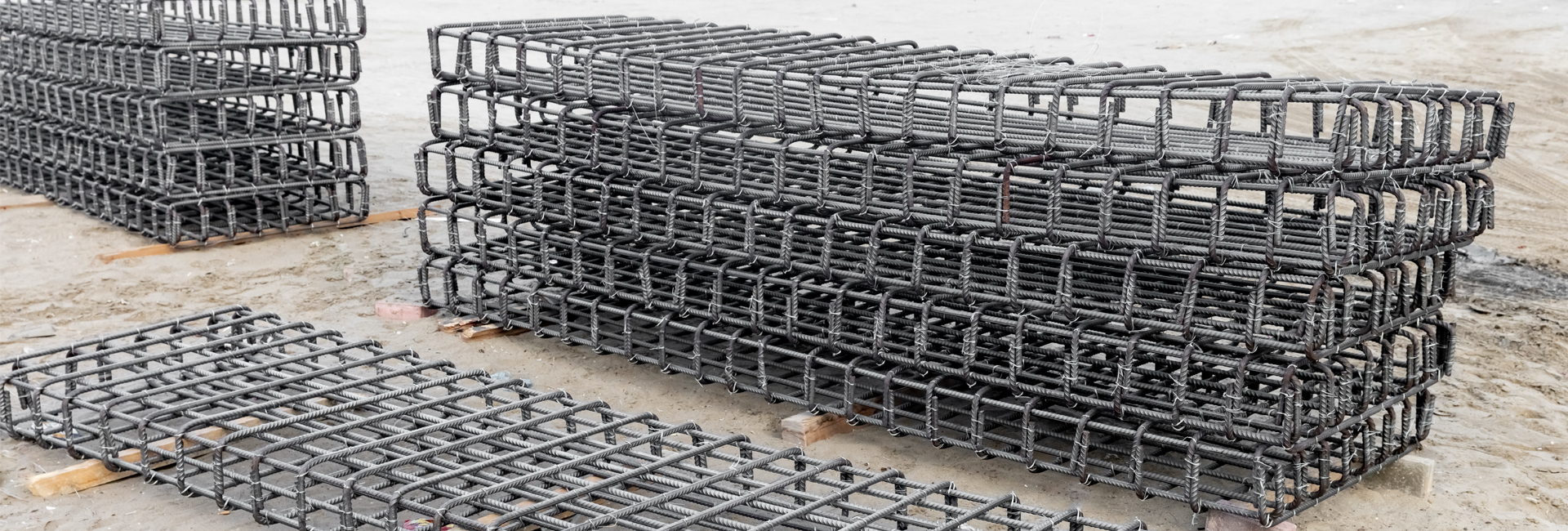The reinforced concrete makes up the backbone of modern construction, further enhanced by steel reinforcement bars, which provide the tensile strength concrete requires. Choosing the correct bar type impacts structural safety, maintenance, durability, and costs. This document describes the common rebar types, their properties, applications, and tips for selection with special emphasis on the Indian construction industry.
What is a rebar?
A rebar, in the simplest form, can be defined as a steel bar or mesh that is fixed in concrete so as to resist tensile, shear, and bending stresses. A rebar is defined by its chemical composition, surface profile, and manufacturing processes, which determine its mechanical actions and behaviours.
Principal types of steel reinforcement bars
Note the following as the principal types of steel reinforcement bars of construction steel in use today:
1. Mild Steel (Plain) Bars
These are known as MS bars or plain bars. These smooth (no ribs) bars are a remnant of the past and have been used for small works and shuttering ties. Their bond with concrete is weaker in comparison to deformed bars, which is why they are used in applications where high concrete tensile bonding strength is not a necessity.
2. Deformed Bars (Ribbed Bars)
Deformed bars, often referred to as ribbed bars, have surface lugs or ribs that enhance mechanical interlocking with concrete. They are the predominant deformation types of reinforcement bars used for structural elements such as beams, slabs, and columns. They are better than plain bars in terms of bond strength and ductility.
3. TMT Bars (Thermo-Mechanically Treated Bars)
TMT Bars are one of the most common manufacturing processes in India. TMT bars have surface cold work and subsequent quenching that creates a hard surface region while the interior remains softer. They have high yield strength, good elongation and excellent weldability, which makes them favourable among types of rebar used in construction in India. Common Indian grades include Fe 415, Fe 500, Fe 550 and Fe 600 (as per national standards).
4. HYSD Bars (High Yield Strength Deformed Bars)
These bars were used prior to the advancement and adoption of TMT. Also deformed, HYSD bars have high yield strength. However, most modern construction incorporates TMT bars, which perform better and are manufactured with more advanced processes than HYSD..
5. Epoxy-Coated Rebar
These are steel bars that, in contrast to plain steel, are covered with a layer of epoxy. They are used in aggressive environments due to the risk of chloride attack, such as for coastal structures, bridges, and parking garages.
6. Stainless Steel Rebar
These types of rebars are made of austenitic and other stainless alloys. They are useful for marine and high-value chemical structures. They do not rust and require no additional coatings and stainless steel materials are used where budget and long-lasting durability matter.
7. Galvanized Rebar
These rebars are made of hot-dip galvanizing steel. They provide additional protection against rust. While stainless steel is more expensive than plain bars. This rebar is more economical than stainless steel. They do improve life expectancy against more corrosive materials.
8. Fibre-Reinforced Polymer (FRP) Bars
These bars are made of glass and carbon, which makes them nonconductive. FRP resists marine corrosion, which often damages other materials. FRPs are used where greater corrosion resistance is needed and where non-conductivity simplifies the installation of electric devices and bridge restoration. Steel materials require a lower modification and adjustment.
9. Welded Wire Mesh (WWM) and Prefabricated Cages
These are the pre-made structures called Bar Cages or Welded Wire Mesh (WWM). They can be used for precast slabs and other elements for constant spacing of rebar. They are sold in standard dimensions and help reduce labour for tying rebar on-site.
How these types differ — mechanical and practical considerations
Bond strength
The TMT and new generations of high-quality rebars exhibit good ductility, which is necessary for seismic regions.
Corrosion resistance
Plain steel is the least protective, while stainless steel offers the most protection, whereas epoxy-coated and galvanized are in the middle. Coastal projects in India need additional protection from corrosion.
Weldability
Many TMT mild steels and grades are weldable, while some high-strength deformed bars and coated bars need special weld procedures.
Thermal treatment effect
The tough core and hard outer surface of TMT bars greatly enhance both strength and energy absorption.
Grades and standards
Reinforcing bars are usually graded in India as Fe 415, Fe 500, Fe 550 and Fe 600, denoting minimum yield stress and criteria needed for the IS standards. Compliance with national standards and mill test certificates is most critical for engineers in the context of taller buildings or reduced reinforcement area, as these yield greater efficiency.
Also Read: Understanding the Different Grades of TMT Bars
How rebar is made and the role of raw materials
Most mills produce rebars by rolling billets made from steel scrap or sponge iron (Direct Reduced Iron). The sponge iron suppliers in India greatly affect the quality of the billets concerning inductive furnace-based producers. Good steel chemistry and tightly controlled rolling/quenching processes throughout the production of TMT are needed for consistent microstructure and performance.
Where each type is typically used
- Foundations and plain slabs: Deformed/TMT bars and welded mesh.
- Columns and beams (structural): For load-bearing and HYSD TMT bars for earthquakes, High-grade TMT or HYSD bars.
- Marine/coastal structures & bridges: Rebar FRP is used for retrofitting Epoxy-coated, galvanized or stainless steel rebar.
- Industrial plants with chemicals: Alloyed bars or stainless steel.
- Rehabilitation and retrofit: FRP or fibre systems may be used where adding mass or excavation is costly.
With engineering and contracting exposure, tips for selection
- Alteration by match grade: Don’t substitute without recalculation.
- Focus exposure: Need corrosion-resistant.
- Check mill test certificates: Issued certificates with their respective values.
- Pay attention to cracks: Diminished bond and durability.
- Add to consideration: Prefabricated cages enhance quality.
- Maintenance counter: Stainless and FRP is costlier initially but reduce spending over time.
Storage, handling and quality control
Reinforcing bars must be kept dry, raised above the ground to prevent moisture accumulation, and organized to prevent grade mix-up. To prevent contamination, cut surfaces must be cleaned prior to concrete bonding. On-site testing, which includes bending, tensile sampling, and dimensional checks, alongside laboratory testing, ensures compliance.
Sustainability and recycling
Steel is one of the easiest metals to recycle. Steel recycling processes and scrap usage have lower energy consumption. However, selecting types of steel reinforcement bars has an impact on life-cycle emissions; long-lasting, corrosion-resistant options tend to provide better life-cycle sustainability.
Conclusion: Choosing the right bar for the job
Knowledge of different types of reinforcement bars enables practitioners to make economical and durable structures. For the majority of routine construction activities in India, the modern TMT/deformed bars (Fe 415/500 grades) offer an economical blend of strength, ductility, and cost. Under aggressive exposure conditions, or in specialised applications, epoxy-coated, galvanized, stainless steel, or FRP may be used. Additionally, for non-negotiable long-term performance, the integrity of supply chains, including sponge iron suppliers in India for the raw materials, and stringent quality control at the mill and construction site must be maintained.
For more information, please reach out to us at: Sales@sreemetaliks.com

